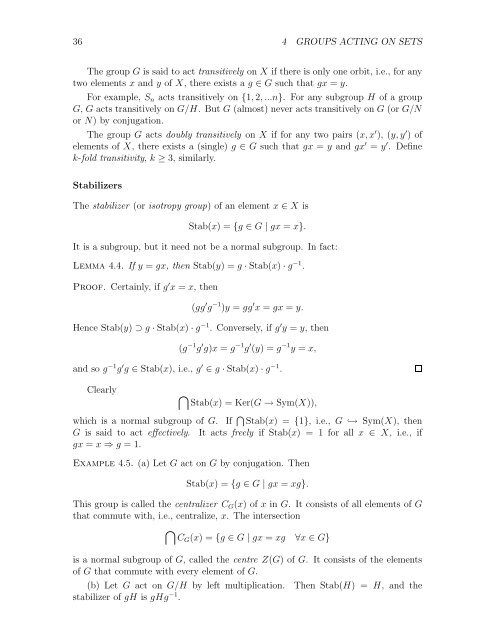Milne - Group Theory.. - Free
Milne - Group Theory.. - Free
Milne - Group Theory.. - Free
Create successful ePaper yourself
Turn your PDF publications into a flip-book with our unique Google optimized e-Paper software.
36 4 GROUPS ACTING ON SETS<br />
The group G is said to act transitively on X if there is only one orbit, i.e., for any<br />
two elements x and y of X, thereexistsag ∈ G suchthat gx = y.<br />
For example, S n acts transitively on {1, 2, ...n}. For any subgroup H of a group<br />
G, G acts transitively on G/H. ButG (almost) never acts transitively on G (or G/N<br />
or N) by conjugation.<br />
The group G acts doubly transitively on X if for any two pairs (x, x ′ ), (y, y ′ )of<br />
elements of X, there exists a (single) g ∈ G suchthat gx = y and gx ′ = y ′ . Define<br />
k-fold transitivity, k ≥ 3, similarly.<br />
Stabilizers<br />
The stabilizer (or isotropy group) ofanelementx ∈ X is<br />
Stab(x) ={g ∈ G | gx = x}.<br />
It is a subgroup, but it need not be a normal subgroup. In fact:<br />
Lemma 4.4. If y = gx, thenStab(y) =g · Stab(x) · g −1 .<br />
Proof. Certainly, if g ′ x = x, then<br />
(gg ′ g −1 )y = gg ′ x = gx = y.<br />
Hence Stab(y) ⊃ g · Stab(x) · g −1 .Conversely,ifg ′ y = y, then<br />
(g −1 g ′ g)x = g −1 g ′ (y) =g −1 y = x,<br />
and so g −1 g ′ g ∈ Stab(x), i.e., g ′ ∈ g · Stab(x) · g −1 .<br />
Clearly<br />
⋂<br />
Stab(x) =Ker(G → Sym(X)),<br />
which is a normal subgroup of G. If ⋂ Stab(x) ={1}, i.e., G↩→ Sym(X), then<br />
G is said to act effectively. It acts freely if Stab(x) = 1 for all x ∈ X, i.e., if<br />
gx = x ⇒ g =1.<br />
Example 4.5. (a) Let G act on G by conjugation. Then<br />
Stab(x) ={g ∈ G | gx = xg}.<br />
This group is called the centralizer C G (x) ofx in G. It consists of all elements of G<br />
that commute with, i.e., centralize, x. The intersection<br />
⋂<br />
CG (x) ={g ∈ G | gx = xg ∀x ∈ G}<br />
is a normal subgroup of G, called the centre Z(G) ofG. It consists of the elements<br />
of G that commute with every element of G.<br />
(b) Let G act on G/H by left multiplication. Then Stab(H) = H, and th e<br />
stabilizer of gH is gHg −1 .

















